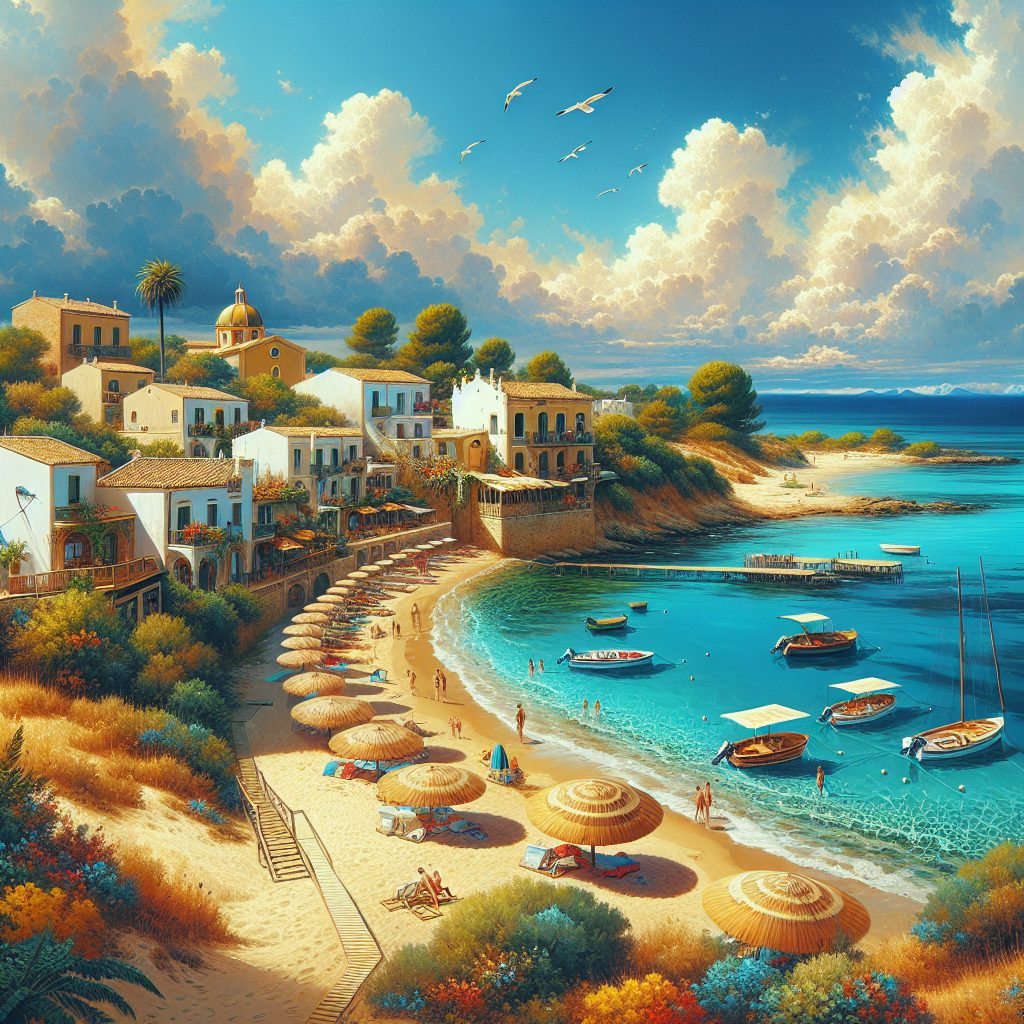Oristano, a province located in the central-western part of the Italian island of Sardinia, boasts a rich archaeological heritage that is bound to captivate history enthusiasts. The Oristano archaeological sites offer a window into the region’s intriguing past, providing valuable insights into ancient civilizations that once thrived in this area. One unique fact about these sites is that they showcase evidence of human presence dating back thousands of years, making them a significant testament to the region’s historical significance.
These archaeological sites in Oristano have left a lasting impact on our understanding of Sardinia’s ancient civilizations. From the awe-inspiring ruins of the ancient city of Tharros, which was once a bustling Phoenician, Carthaginian, and Roman city, to the well-preserved nuraghe structures, Oristano offers a diverse range of archaeological wonders to explore. The nuraghe, circular stone structures built by the Nuragic civilization, stand tall as silent witnesses to a society that flourished during the Bronze and Iron Ages.
In the next part of this article, we will delve deeper into these fascinating archaeological sites in Oristano. We will explore the key takeaways from each site, unraveling the mysteries held within their ancient walls. Join us as we embark on a journey through time, uncovering the secrets of Oristano’s remarkable archaeological sites.
Key Takeaways
1. The Oristano archaeological sites in Sardinia showcase the rich history of the region, with artifacts dating back thousands of years.
2. The sites include the Nuraghe Losa, a well-preserved complex of towers and village structures that offers a glimpse into the lives of ancient civilizations.
3. The Phoenician settlement of Tharros, located on a picturesque coastline, reveals the influence of this ancient trading empire on the region.
4. The Roman ruins of Fordongianus provide evidence of the Roman Empire’s presence, with well-preserved thermal baths and a theater.
5. The Oristano archaeological sites offer visitors a unique opportunity to explore the diverse history of Sardinia, from ancient Nuragic communities to the Roman period.
1. What are the fascinating archaeological sites in Oristano that you shouldn’t miss during your visit?
2.
Tharros: Unveiling the Ancient Phoenician Influence
Tharros, one of the most renowned archaeological sites in Oristano, offers a fascinating glimpse into the ancient Phoenician influence in the region. Situated on the southern coast of the Sinis Peninsula, Tharros dates back to the 8th century BC. As you explore the ruins, you’ll come across well-preserved structures such as temples, houses, and a necropolis. The site’s strategic coastal location also provides breathtaking views of the Mediterranean Sea.
3.
Santu Antine: A Journey into Nuragic Civilization
Delve into the mysterious Nuragic civilization at the Santu Antine archaeological site. This complex, located near the village of Torralba, is home to a remarkable nuraghe, a unique type of prehistoric stone structure found only in Sardinia. As you wander through the site, you’ll encounter intricate stone carvings, ancient artifacts, and fascinating insights into the daily life and rituals of the Nuragic people.
4.
Oristano Cathedral: A Blend of Romanesque and Gothic Influences
The Oristano Cathedral is not only a religious landmark but also holds immense historical and architectural significance. Constructed in the 13th century, this stunning cathedral showcases a captivating blend of Romanesque and Gothic styles. Admire its intricate facade, ornate rose window, and impressive bell tower. Step inside to marvel at the beautiful frescoes, sculptures, and religious artifacts that tell the tales of Oristano’s past.
5.
Cornus: Discovering the Ancient Roman City
Travel back in time to the ancient Roman era by exploring the archaeological site of Cornus. Located near the town of Seneghe, Cornus was once a vibrant Roman city bustling with life. As you wander through its ruins, you’ll stumble upon remnants of grand buildings, paved streets, thermal baths, and even a theater. Immerse yourself in the rich history and culture that thrived here centuries ago.
6.
Museum Antiquarium Arborense: Preserving Oristano’s Archaeological Treasures
Curious about the artifacts unearthed from Oristano’s archaeological sites? The Museum Antiquarium Arborense is where you’ll find an impressive collection of ancient treasures. From stunning ceramics to intricate jewelry, this museum showcases the archaeological significance of the region. Explore its exhibits to gain a deeper understanding of Oristano’s rich history and the various civilizations that shaped it.
7.
Exploring Beyond Oristano: Nearby Archaeological Wonders
If you’re eager to continue your archaeological adventure beyond Oristano, there are several notable sites in the surrounding areas. Visit the sacred well of Santa Cristina, a Nuragic water sanctuary with a striking central staircase. Head to the archaeological site of Losa, where you can explore an ancient Nuragic village and its mesmerizing megalithic structures. Don’t miss the charming village of Fordongianus, home to an impressive Roman thermal baths complex.
8.
Guides and Tips:
- Plan your visits to Oristano’s archaeological sites in advance to make the most of your time.
- Wear comfortable footwear suitable for exploring archaeological ruins.
- Consider hiring a knowledgeable guide to enhance your understanding of the sites’ historical and cultural significance.
- Bring a camera to capture the stunning architecture and scenic views.
- Check the opening hours and any entry requirements for each site before your visit.
Frequently Asked Questions
1. What are the main archaeological sites in Oristano?
Oristano boasts several significant archaeological sites, including the Tharros ruins, Nuraghe Losa, and the Giants’ Tombs in Cabras.
2. Can I visit Tharros ruins in Oristano?
Absolutely! Tharros is a captivating ancient city located on the west coast of Sardinia, near Oristano. Visitors can explore the remarkable ruins, including temples, markets, and Roman baths.
3. What can I expect to see at Nuraghe Losa?
Nuraghe Losa is a remarkable Nuragic complex situated near Abbasanta, close to Oristano. If you visit, you can marvel at the impressive central tower and the remains of surrounding buildings, which provide insights into the Nuragic civilization.
4. Are the Giants’ Tombs worth visiting in Cabras?
Absolutely! The Giants’ Tombs in Cabras are fascinating ancient burial sites, comprising massive stone structures resembling elongated dolmens. Exploring these tombs provides a unique glimpse into the ancient rituals and beliefs of the region.
5. Are guided tours available for these archaeological sites?
Yes, guided tours are available for all the major archaeological sites in Oristano. Professional guides can provide in-depth information about the historical significance, architecture, and cultural context of each site.
6. How long does it take to visit Tharros ruins?
The duration of your visit to Tharros ruins depends on your interests and exploration style. On average, visitors spend around 2-3 hours exploring the site, but you can adjust the time according to your preferences.
7. Can I take photographs at the archaeological sites?
Yes, photography is allowed at most archaeological sites in Oristano. However, it is advisable to check for any specific restrictions or guidelines at each site when you visit.
8. Is there an entrance fee for these archaeological sites?
Yes, there is an entrance fee for most archaeological sites in Oristano. The fees help with the maintenance and preservation of these historic sites, ensuring their existence for future generations.
9. Are these archaeological sites accessible for people with disabilities?
Efforts have been made to improve accessibility at the archaeological sites in Oristano, but some locations may have limitations due to their natural or historical characteristics. It is recommended to contact the specific sites in advance to obtain detailed accessibility information.
10. Can I purchase souvenirs near these archaeological sites?
Yes, there are often gift shops or stalls near the entrance or exit of the archaeological sites in Oristano. These places offer a variety of souvenirs, including books, postcards, traditional crafts, and local products.
Final Thoughts
Exploring the archaeological sites in Oristano is like stepping back in time and immersing yourself in the rich history and cultural heritage of the region. These sites bear witness to the ancient civilizations that once thrived here, leaving behind valuable remnants of their existence that continue to captivate visitors.
Whether you are a history enthusiast, an archaeology lover, or simply seeking a unique cultural experience, Oristano’s archaeological sites offer a journey through time that will leave you in awe. From the impressive ruins of Tharros to the enigmatic Nuraghe Losa and the intriguing Giants’ Tombs, each site has its own captivating story to tell. Take the opportunity to embrace the past and gain a deeper understanding of this fascinating corner of Sardinia.






